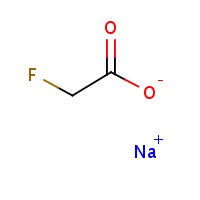Note from Fluoride Action Network:
Molecular structure of highly toxic Sodium fluoroacetate (known as 1080). For more info, albeit outdated, click here

A pest control company was under pressure to meet supply demands when it tried to make the active ingredient in the pesticide 1080 and a worker ended up in an induced coma.
This was reported in the Christchurch District Court on Wednesday where Pest Control Research Ltd was fined $275,000 over the incident.
The worker was hospitalised for four weeks in May 2019 after being exposed to a poisonous substance at a unit in Bromley, Christchurch, leased by Pest Control Research. After being discharged from hospital, the worker had to receive hemodialysis for some time and was only able to return to work two months later.
The company was under pressure to meet its supply obligations and decided to try to manufacture sodium fluoroacetate – the active ingredient in 1080 – locally rather than importing it.
The company had approval to manufacture 1080 bait at its Rolleston facility but the necessary “resource consent barriers” were not in place at the Bromley facility.
Judge Quinton Hix said the company “took shortcuts” to get the manufacturing up and running as soon as possible.
“It was a case of getting the material manufactured and … health and safety was relegated to a secondary consideration.”
WorkSafe prosecutor Anna Longdill said these failures were not merely due to “an error of judgment” on the company’s part.
Pest Control Research wilfully ignored the advice from an independent expert about the safeguards and systems it needed to manufacture such a hazardous substance, she said.
Pest Control Research counsel Scott Wilson said the company obtained external expertise but relied on advice from internal experts who were “highly experienced and highly qualified”.
“There were systems in place but they could have been better and that is accepted,” he said.
Judge Hix said the company had a responsibility to ensure it conducted its business safely and in line with relevant regulations. He described it as “a case of wilful blindness”.
The judge said that if the company had taken more time to sufficiently prepare its manufacturing process, it was unlikely the incident would have happened.
Wilson said the company was dealing with a “niche enterprise” that had no “blueprint” for its operation.
“It was not a case of just [being able] to Google the process. It may have been the case that there was a departure from industry standards but it is not as significant or as great as the prosecution is submitting.”
The company earlier pleaded guilty to four charges laid by WorkSafe.
It admitted it had failed to ensure that it had a site plan in place, that the location had a current compliance certificate, that a current safety data sheet for the hazardous substances was readily accessible, and that workers were not exposed to a risk of death or serious illness from exposure to hazardous substances.
The company was ordered to pay a total reparation of $30,000 to the injured worker, some of which has already been paid. Pest Control Research was also ordered to pay about $96,000 towards WorkSafe’s investigation and legal costs.
